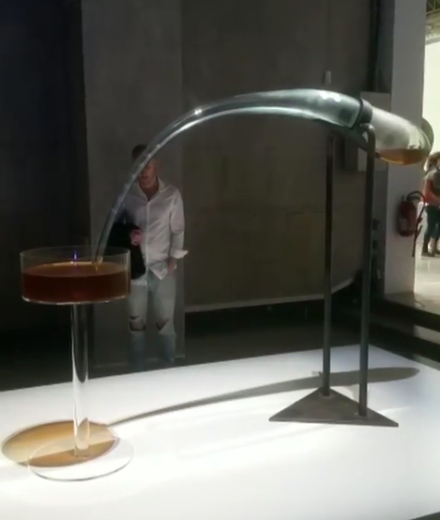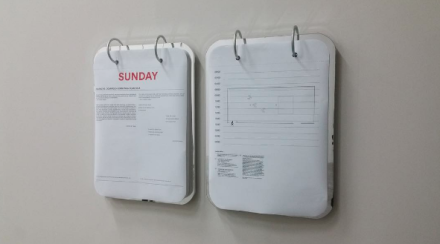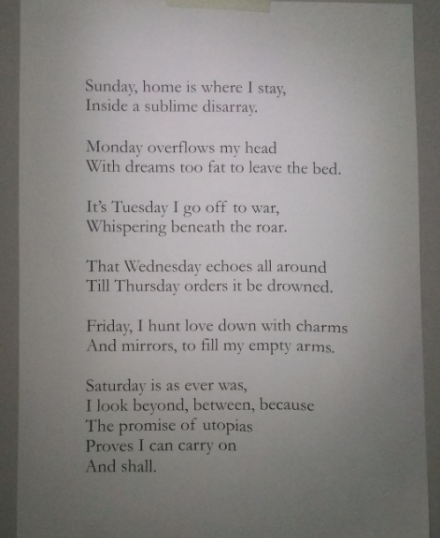
Camillle Henrot, Days Are Dogs (Installation View), via Art Observed
Camille Henrot works better on a grand scale. The Golden Lion-winning French artist, whose enigmatic and playful sculptures, paintings and installations dwell on the phenomenology of life, and an often overwhelming range of lived experience, seems to draw additional strength from working with as much space as possible, perhaps best seen in her last show at Metro Pictures in New York, where a range of concepts and ideas allowed the viewer to move effortlessly through experiences of neurosis, guilt, pain and anger through to more primal emotions, and on through to a coy fusion of the two in the language of modernity.

Camillle Henrot, Days Are Dogs (Installation View), via Art Observed

Work by Avery Singer in the midst of the artist’s show, via Art Observed
It’s no surprise then, that the artist’s sprawling style would go so smoothly hand-in-hand with the spacious confines of the Palais de Tokyo in Paris, an institution that has frequently supported the artist’s work as she has grown and evolved in style and vision. Here, the exhibition space has afforded her “carte blanche,” allowing her to flex her creative vision and creative capacities across several rooms of varied works and experiential installations.

Camillle Henrot, Days Are Dogs (Installation View), via Art Observed
Reprising some of the themes explored in the aforementioned Metro Pictures exhibition, Henrot delves into the act of living in the present day, populating her body of work with inflections of guilt, visceral bodily experience, and imagistic fantasies that swirl and twist around the viewer as they pass through space. In one room, photographs, paintings and staged scenes do battle for the visitor’s attention, each adding to a sort of documentary of the imagination, a constant exploration of the human act of moving through the world, and the countless interpretations and iterations of reality we make as reasoning individuals.

Camillle Henrot, Days Are Dogs (Installation View), via Art Observed
Elsewhere, Henrot explores various bodily movements through her expressive sculptural practice, drawing the lines of the European avant-garde through her own interest in the human experience of modernity. Forms and bodies swirl through the given space, complemented by the inclusion of a soft gym mat spread throughout one room. Allowing these inflections of the contemporary landscape into her works, Henrot seems to invite a re-appreciation of the concept of the avant-garde’s interest in the intrusion of art into the modern world in reverse, allowing everyday surroundings to suddenly surge into the gallery, and contend with the viewer’s experience of the works around it.

Camillle Henrot, Days Are Dogs (Installation View), via Art Observed
The result is a space where neither art object nor personal experiences, signifiers or symbols are allowed to exist in a clinically-dead space, instead forcing the viewer to constantly evaluate their position and relation to each object, and to the space itself. When considered against the artist’s familiar payphone sculptures, which invite cryptic interpretations of modern psychological complexes and social conflicts, this self-sustaining universe seems to reach its apex, a fully-populated landscape of emotions, things and ideas sustained within the gallery.

Camillle Henrot, Days Are Dogs (Installation View), via Art Observed
Henrot takes great interest in the understanding and exploration of ecologies in her work. Her pieces are elements and actors in a network of emotions and thoughts, fantasies and dreams suspended in the gallery in a manner that almost works backwards on the viewer to push their subconscious longings and feelings into the world around them. Leaving the show, one is confronted with the choice to treat these thoughts as independent agents, even as new ones arise in the midst of the everyday. If Henrot’s work has a rhetorical imperative, it may be the argument as to how one acts on these thoughts.
Days are Dogs is on view through January 7th, 2018.
— D. Creahan
Read more:
Palais de Tokyo [Exhibition Site]



